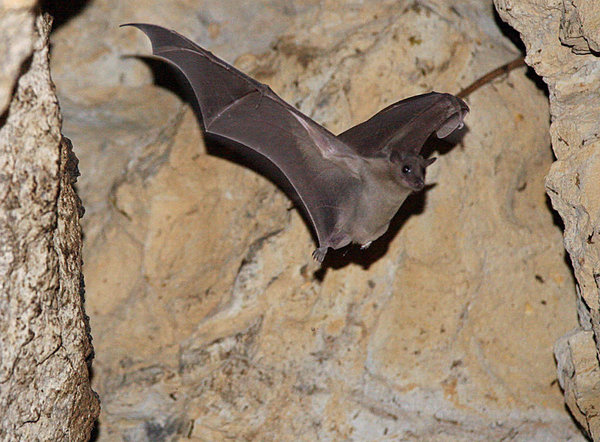
An Egyptian fruit bat flies in an abandoned quarry near the village of Mammari, west of Nicosia, in March 2007. Alex Mita / AFP - Getty Images file
At a lab at the Weizmann Institute of Science in Israel, fruit bats in a roomy cage flew circles around a metal rig that roughly resembles a tree. Electrodes on their head recorded and wirelessly transmitted a map of the electrical activity in their brain. Bats, like birds, are deviously good at finding their way over long distances. Egyptian fruit bats will fly up to a hundred kilometers from their roosting cave to visit a favorite fruit tree. By studying the brain activity, researchers hoped to uncover clues about how many mammals, not just bats, know where they are — how high up they are when they peek out of a 10th-story window, how far they need to leap so they can make it to the next branch, or how to make back it home once they’ve reached their favorite tree.
Five thousand miles away, at Boston University, neuroscientists sought answers to some of the same questions. They tracked electric signals in slices of rat and bat brain tissue for evidence of certain rhythmic electrical pings. Such pings have been thought to play a key role in navigation and space awareness.
Months later, these readings from both the flying bats and the “cold cut” slices of brain tissue are now challenging one of the leading explanations for how mammalian brains interpret the space around them. The new findings indicate that the rhythmic firing of neurons — a feature frequently found in brain-wave scans for all kinds of mammals — may not play as central a role in understanding space as previously thought. Two papers describing the work appear in Friday’s issue of the journal Science.
Nachum Ulanovsky, a neuroscientist at the Weizmann Institute and one of the flying bat watchers, was tracking signals from the hippocampus, the part of the brain that deals with spatial memory and is understood to play a key role in navigation.
Hippocampal neurons discovered in the 1970s help bats and other mammals map a new space, he explained to NBC News. When these neurons, known as “place cells,” were tracked in a rat’s brain, each location of the room activated a different and specific group of cells. Place cells are fed information from “grid cells,” which have been observed at work in various moving mammals. In the brains of rhesus monkeys, grid-like cells were seen to activate when the sitting primates just tracked their eyes across a room.
One theory for how these compasses in the brain go about their space-coding business implicates a rhythmic, periodic pinging of neurons, called “theta oscillations.”
“You’re sitting [at] the stadium and everyone is talking together — you hear a background hum, [but] if everyone starts chanting their name together, you hear a very clear up and down auditory output,” Michael Hasselmo, a Boston University neuroscientist and co-author of one of the new studies, told NBC News. That’s sort of how the neurons behave.
Studied for the first time in flying fruit bats, these signature oscillations were absent, both in the flying animals and in the stimulated slices of tissue. Previously studied crawling bats didn’t show evidence of the oscillations, either. “We did this in flight, and still we don’t get those,” Ulanovsky of the Weizmann Institute told NBC News.
In the rat tissue, though? Those neurons were pinging away as expected. The fact that rats and rat brain tissue have place and grid cells, but not run by the usual rhythms, raises the possibility that navigation systems in rats and bats evolved separately but converged towards a similar goal, Hasselmo and his co-authors write in their paper.
Edvard Moser, who was not involved with either work but did early work on grid cells at the Kavli Institute for Systems Neuroscience in Norway, believes that the structure of place cells and grid cells in rats and bat brains are too similar for this to be the case.
Rather, the rhythmic dance of neurons could play a more general role in storing information. “It’s important for blocking information and for defining sequences ... and making cells fire at the right order and at the right time,” Moser told NBC News.
Click here for article.
